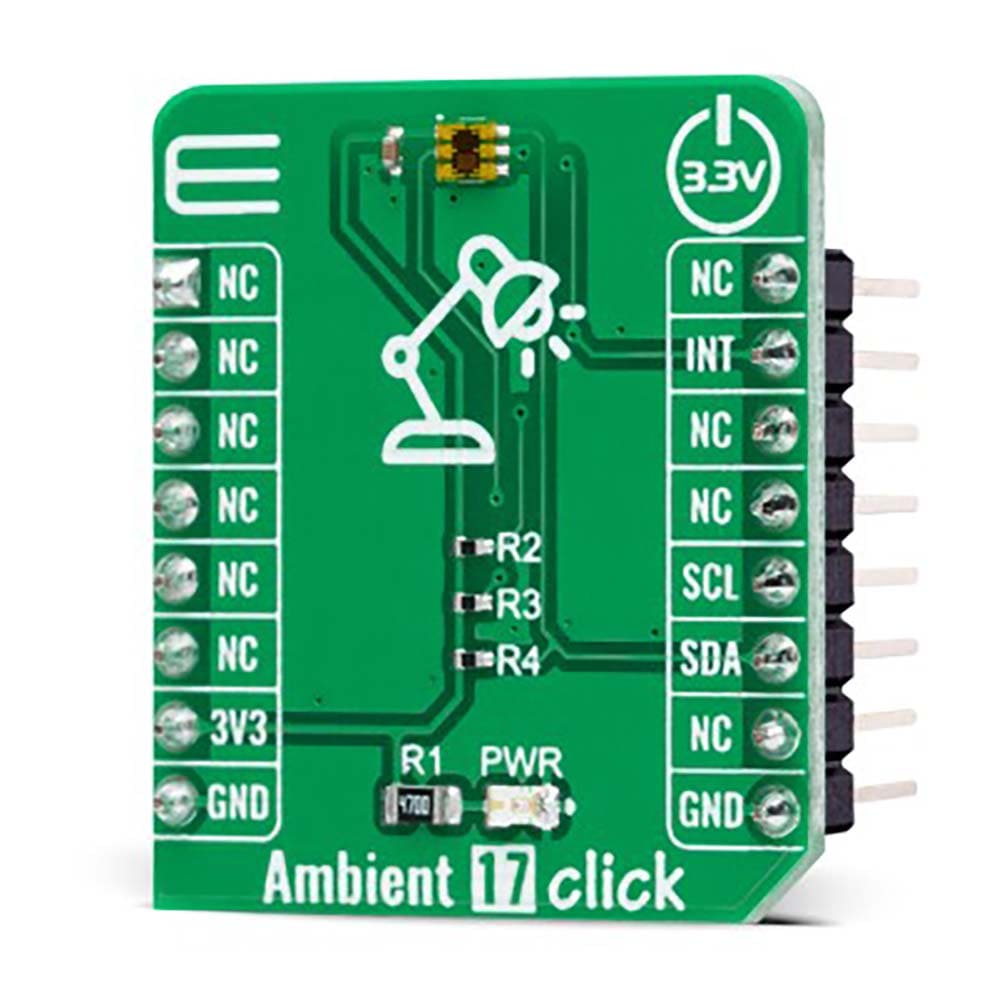
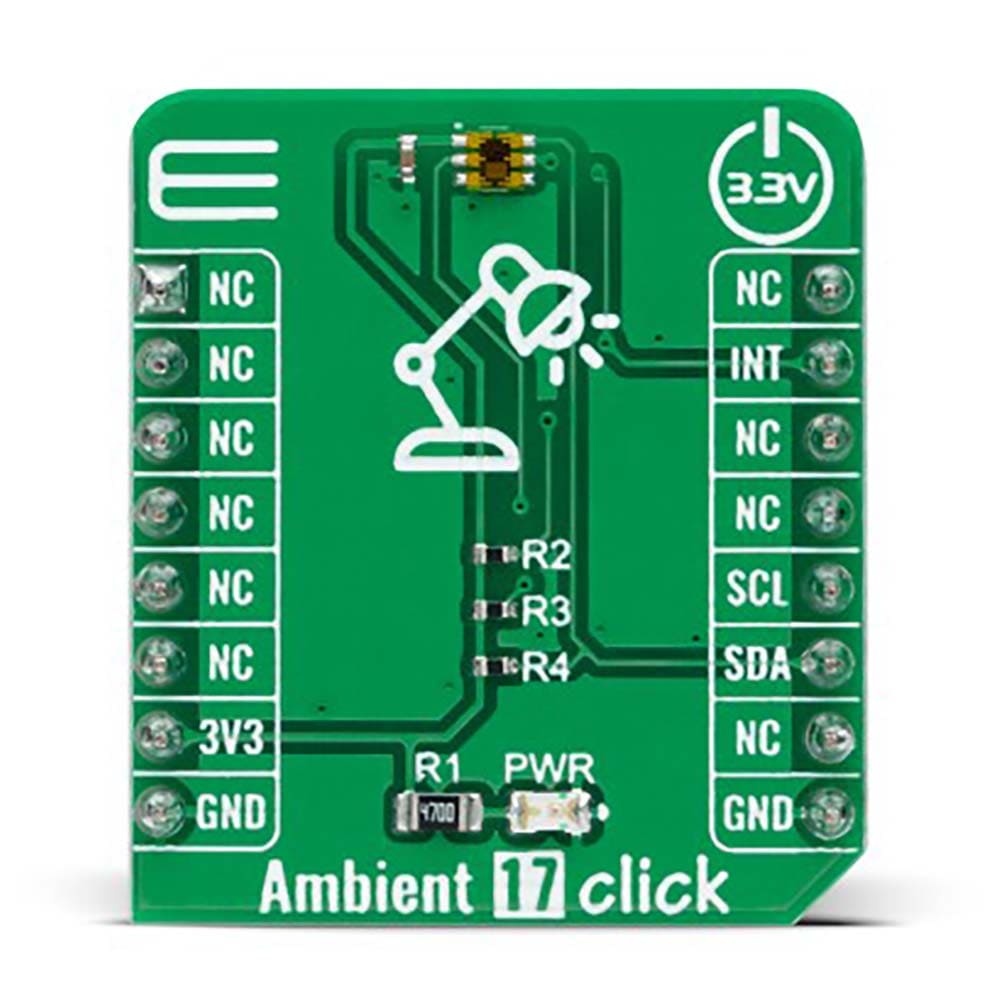
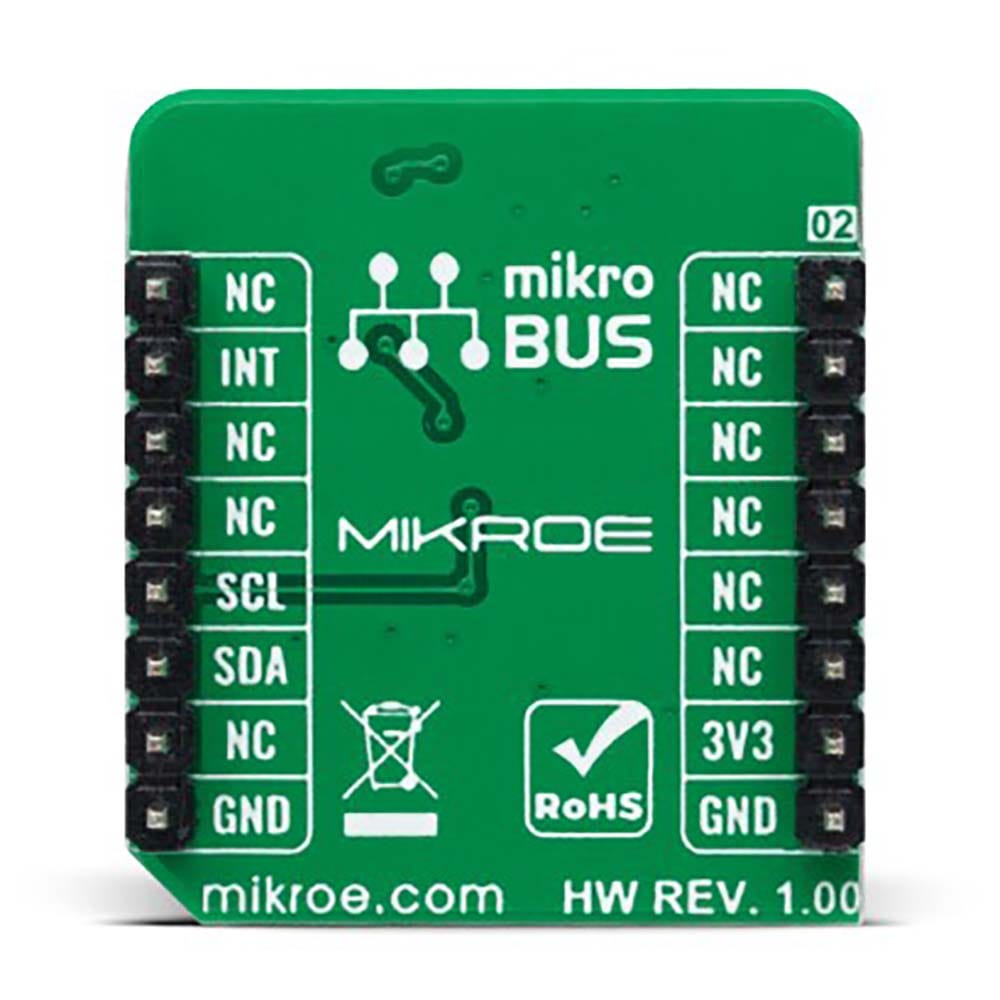

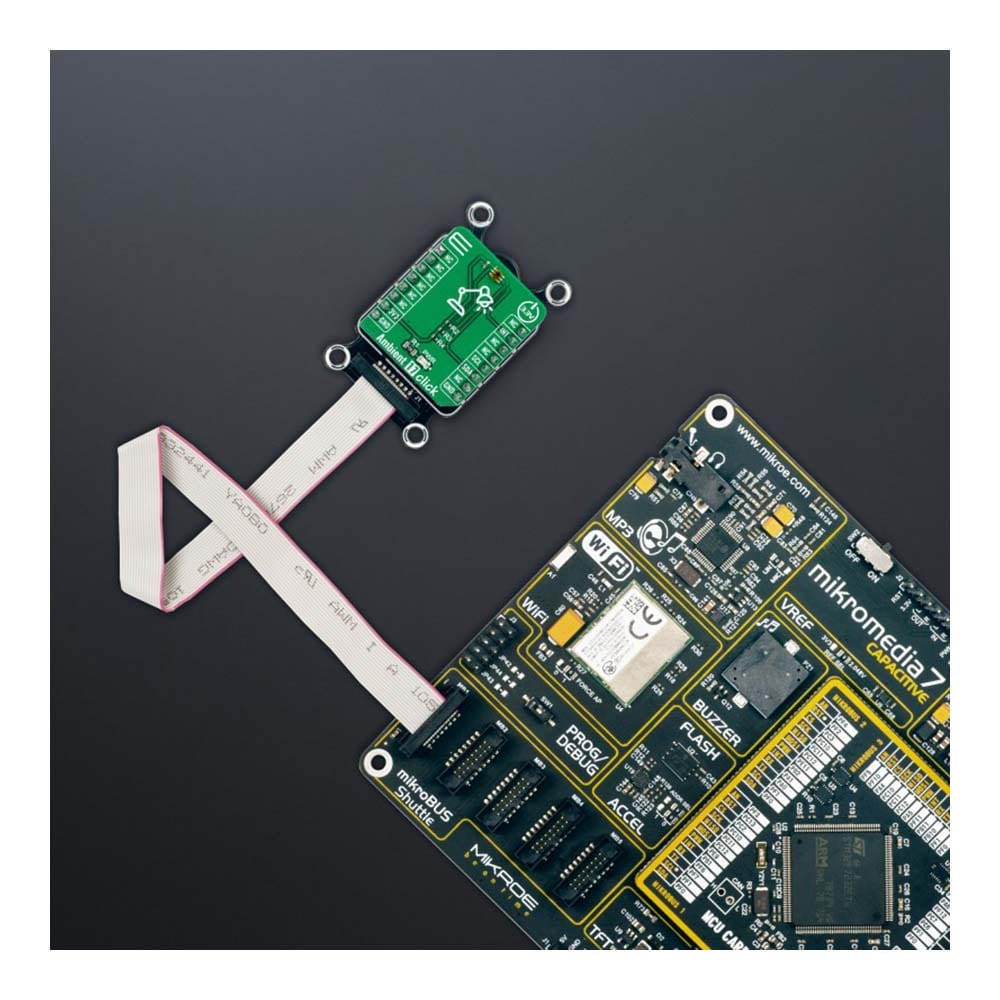
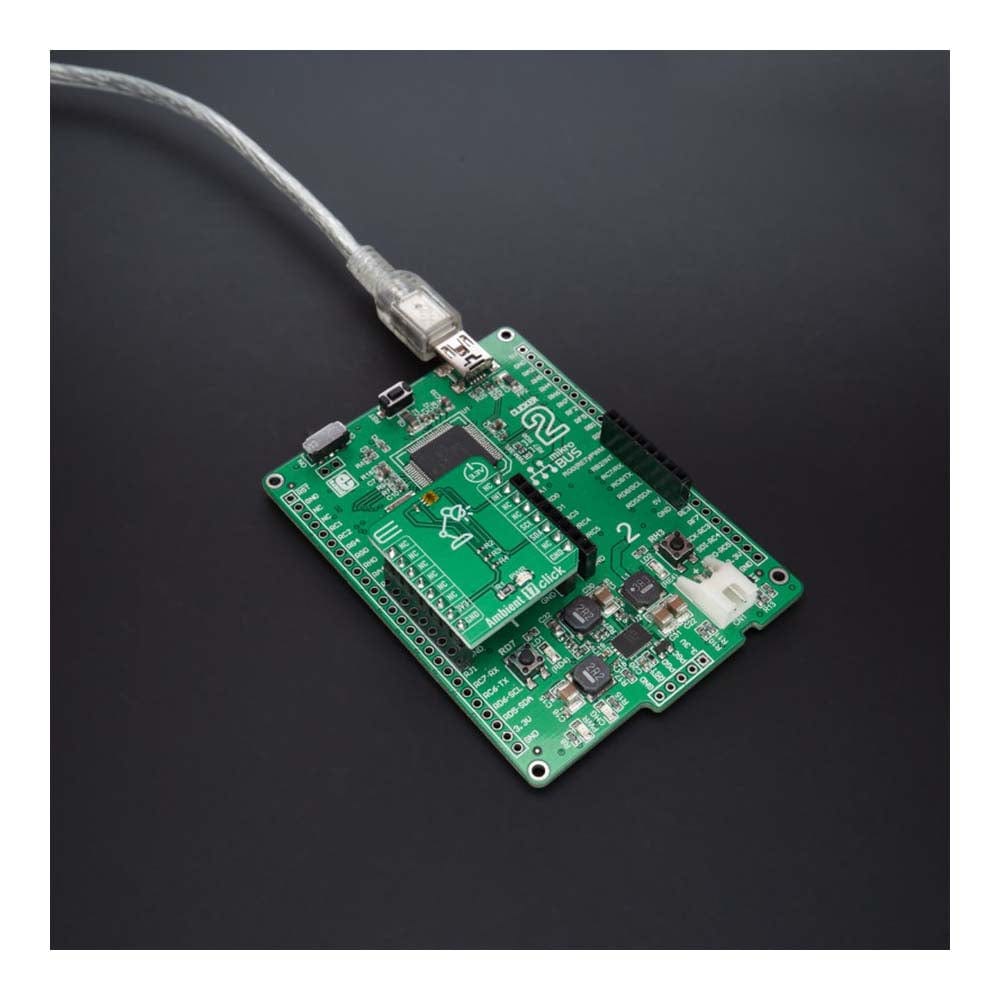

Key Features
Overview
The Ambient 17 Click Board™ is a compact add-on board used to measure the amount of the present ambient light. This board features the TSL2572, a digital-output ambient light sensor with an I2C interface from AMS AG. The TSL2572 can detect a wide range of illuminance up to 60klx and provides excellent responsivity close to the human eyes' response. It is designed to control the brightness in various applications based on ambient light availability, brightness for optimum visibility, and energy efficiency. Operation in a temperature range of -30°C to 70°C ensures stable operation under extreme conditions. This Click board™ is the most suitable for obtaining ambient light data for adjusting brightness in applications that require power saving and better visibility.
The Ambient 17 Click Board™ is supported by a mikroSDK compliant library, which includes functions that simplify software development. This Click board™ comes as a fully tested product, ready to be used on a system equipped with the mikroBUS™ socket.
Downloads
How Does The Ambient 17 Click Board™ Work?
The Ambient 17 Click Board™ as its foundation uses the TSL2572, a high sensitivity light-to-digital converter that transforms light intensity into a digital output signal from AMS AG. The TSL2572 provides ambient light sensing (ALS) that approximates human eye response to light intensity under various lighting conditions and through a variety of attenuation materials. Accurate ALS measurements result from dual-diode technology and the UV rejection filter incorporated in the package. In addition, the TSL2584TSV can detect a wide range of precise lux measurements up to 60klx, even when mounted behind dark glass. It also has stable performance over a wide temperature range of -30°C to 70°C, suitable for measuring the present ambient light.
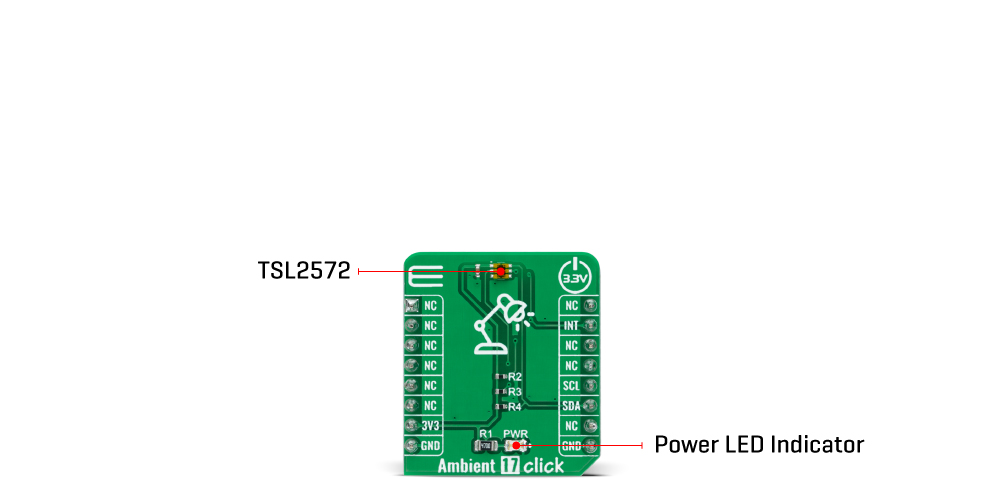
The Ambient 17 Click Board™ communicates with MCU using the standard I2C 2-Wire interface to read data and configure settings, supporting Standard Mode operation with a clock frequency of 100kHz and Fast Mode up to 400kHz. It also possesses an additional interrupt signal, routed on the INT pin of the mikroBUS™ socket labelled as INT, indicating when a specific interrupt event occurs, such as detecting a meaningful change in light intensity. An interrupt is generated when the value of an ALS conversion exceeds either an upper or lower threshold. In addition, a programmable interrupt persistence feature allows the user to determine how many consecutive exceeded thresholds are necessary to trigger an interrupt.
The Ambient 17 Click Board™ can be operated only with a 3.3V logic voltage level. The board must perform appropriate logic voltage level conversion before using MCUs with different logic levels. However, the Click board™ comes equipped with a library containing functions and an example code that can be used, as a reference, for further development.
SPECIFICATIONS
| Type | Optical |
| Applications | The Ambient 17 Click Board™ can be used for obtaining ambient light data for adjusting brightness in applications that require power saving and better visibility |
| On-board modules | TSL2572 - high sensitivity light-to-digital converter that transforms light intensity into a digital output signal from ams AG |
| Key Features | Low power consumption, corresponds to a dark window because of high sensitivity, close responsivity to the human eye, I2C interface, wide operational range, stable performance over temperature, and more |
| Interface | I2C |
| Compatibility | mikroBUS |
| Click board size | S (28.6 x 25.4 mm) |
| Input Voltage | 3.3V |
PINOUT DIAGRAM
This table shows how the pinout of the Ambient 17 Click Board™ corresponds to the pinout on the mikroBUS™ socket (the latter shown in the two middle columns).
| Notes | Pin |  |
Pin | Notes | |||
|---|---|---|---|---|---|---|---|
| NC | 1 | AN | PWM | 16 | NC | ||
| NC | 2 | RST | INT | 15 | INT | Interrupt | |
| NC | 3 | CS | RX | 14 | NC | ||
| NC | 4 | SCK | TX | 13 | NC | ||
| NC | 5 | MISO | SCL | 12 | SCL | I2C Clock | |
| NC | 6 | MOSI | SDA | 11 | SDA | I2C Data | |
| Power Supply | 3.3V | 7 | 3.3V | 5V | 10 | NC | |
| Ground | GND | 8 | GND | GND | 9 | GND | Ground |
ONBOARD SETTINGS AND INDICATORS
| Label | Name | Default | Description |
|---|---|---|---|
| LD1 | PWR | - | Power LED Indicator |
AMBIENT 17 CLICK ELECTRICAL SPECIFICATIONS
| Description | Min | Typ | Max | Unit |
|---|---|---|---|---|
| Supply Voltage | - | 3.3 | - | V |
| Illuminance Measurement Range | 0 | - | 60.000 | lx |
| Resolution | - | 16 | - | bits |
| Operating Temperature Range | -30 | +25 | +70 | °C |
| General Information | |
|---|---|
Part Number (SKU) |
MIKROE-5106
|
Manufacturer |
|
| Physical and Mechanical | |
Weight |
0.02 kg
|
| Other | |
Country of Origin |
|
HS Code Customs Tariff code
|
|
EAN |
8606027388996
|
Warranty |
|
Frequently Asked Questions
Have a Question?
Be the first to ask a question about this.







